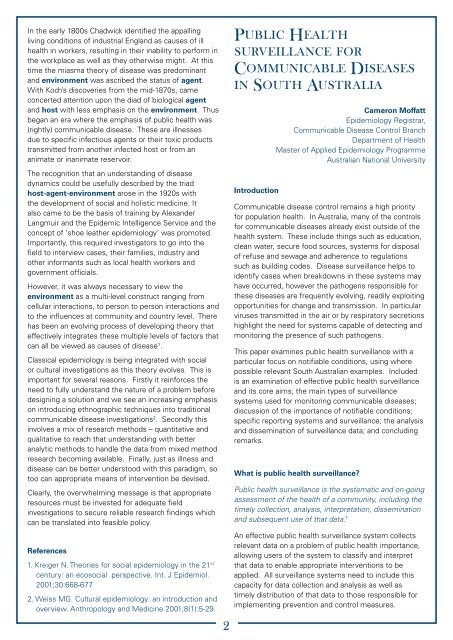Public Health and Communicable Diseases - SA Health - SA.Gov.au
Public Health and Communicable Diseases - SA Health - SA.Gov.au
Public Health and Communicable Diseases - SA Health - SA.Gov.au
You also want an ePaper? Increase the reach of your titles
YUMPU automatically turns print PDFs into web optimized ePapers that Google loves.
In the early 1800s Chadwick identified the appallingliving conditions of industrial Engl<strong>and</strong> as c<strong>au</strong>ses of illhealth in workers, resulting in their inability to perform inthe workplace as well as they otherwise might. At thistime the miasma theory of disease was predominant<strong>and</strong> environment was ascribed the status of agent.With Koch’s discoveries from the mid-1870s, cameconcerted attention upon the diad of biological agent<strong>and</strong> host with less emphasis on the environment. Thusbegan an era where the emphasis of public health was(rightly) communicable disease. These are illnessesdue to specific infectious agents or their toxic productstransmitted from another infected host or from ananimate or inanimate reservoir.The recognition that an underst<strong>and</strong>ing of diseasedynamics could be usefully described by the triadhost-agent-environment arose in the 1920s withthe development of social <strong>and</strong> holistic medicine. Italso came to be the basis of training by Alex<strong>and</strong>erLangmuir <strong>and</strong> the Epidemic Intelligence Service <strong>and</strong> theconcept of ‘shoe leather epidemiology’ was promoted.Importantly, this required investigators to go into thefield to interview cases, their families, industry <strong>and</strong>other informants such as local health workers <strong>and</strong>government officials.However, it was always necessary to view theenvironment as a multi-level construct ranging fromcellular interactions, to person to person interactions <strong>and</strong>to the influences at community <strong>and</strong> country level. Therehas been an evolving process of developing theory thateffectively integrates these multiple levels of factors thatcan all be viewed as c<strong>au</strong>ses of disease 1 .Classical epidemiology is being integrated with socialor cultural investigations as this theory evolves. This isimportant for several reasons. Firstly it reinforces theneed to fully underst<strong>and</strong> the nature of a problem beforedesigning a solution <strong>and</strong> we see an increasing emphasison introducing ethnographic techniques into traditionalcommunicable disease investigations 2 . Secondly thisinvolves a mix of research methods – quantitative <strong>and</strong>qualitative to reach that underst<strong>and</strong>ing with betteranalytic methods to h<strong>and</strong>le the data from mixed methodresearch becoming available. Finally, just as illness <strong>and</strong>disease can be better understood with this paradigm, sotoo can appropriate means of intervention be devised.Clearly, the overwhelming message is that appropriateresources must be invested for adequate fieldinvestigations to secure reliable research findings whichcan be translated into feasible policy.References1. Kreiger N. Theories for social epidemiology in the 21 stcentury: an ecosocial perspective. Int. J Epidemiol.2001;30:668-677.2. Weiss MG. Cultural epidemiology: an introduction <strong>and</strong>overview. Anthropology <strong>and</strong> Medicine 2001;8(1):5-29.<strong>Public</strong> <strong>Health</strong>surveillance for<strong>Communicable</strong> <strong>Diseases</strong>in South AustraliaIntroductionCameron MoffattEpidemiology Registrar,<strong>Communicable</strong> Disease Control BranchDepartment of <strong>Health</strong>Master of Applied Epidemiology ProgrammeAustralian National University<strong>Communicable</strong> disease control remains a high priorityfor population health. In Australia, many of the controlsfor communicable diseases already exist outside of thehealth system. These include things such as education,clean water, secure food sources, systems for disposalof refuse <strong>and</strong> sewage <strong>and</strong> adherence to regulationssuch as building codes. Disease surveillance helps toidentify cases when breakdowns in these systems mayhave occurred, however the pathogens responsible forthese diseases are frequently evolving, readily exploitingopportunities for change <strong>and</strong> transmission. In particularviruses transmitted in the air or by respiratory secretionshighlight the need for systems capable of detecting <strong>and</strong>monitoring the presence of such pathogens.This paper examines public health surveillance with aparticular focus on notifiable conditions, using wherepossible relevant South Australian examples. Includedis an examination of effective public health surveillance<strong>and</strong> its core aims; the main types of surveillancesystems used for monitoring communicable diseases;discussion of the importance of notifiable conditions;specific reporting systems <strong>and</strong> surveillance; the analysis<strong>and</strong> dissemination of surveillance data; <strong>and</strong> concludingremarks.What is public health surveillance?<strong>Public</strong> health surveillance is the systematic <strong>and</strong> on-goingassessment of the health of a community, including thetimely collection, analysis, interpretation, dissemination<strong>and</strong> subsequent use of that data. 1An effective public health surveillance system collectsrelevant data on a problem of public health importance,allowing users of the system to classify <strong>and</strong> interpretthat data to enable appropriate interventions to beapplied. All surveillance systems need to include thiscapacity for data collection <strong>and</strong> analysis as well astimely distribution of that data to those responsible forimplementing prevention <strong>and</strong> control measures.
















